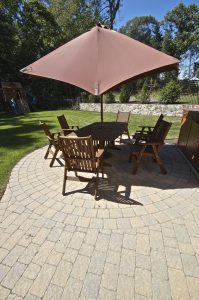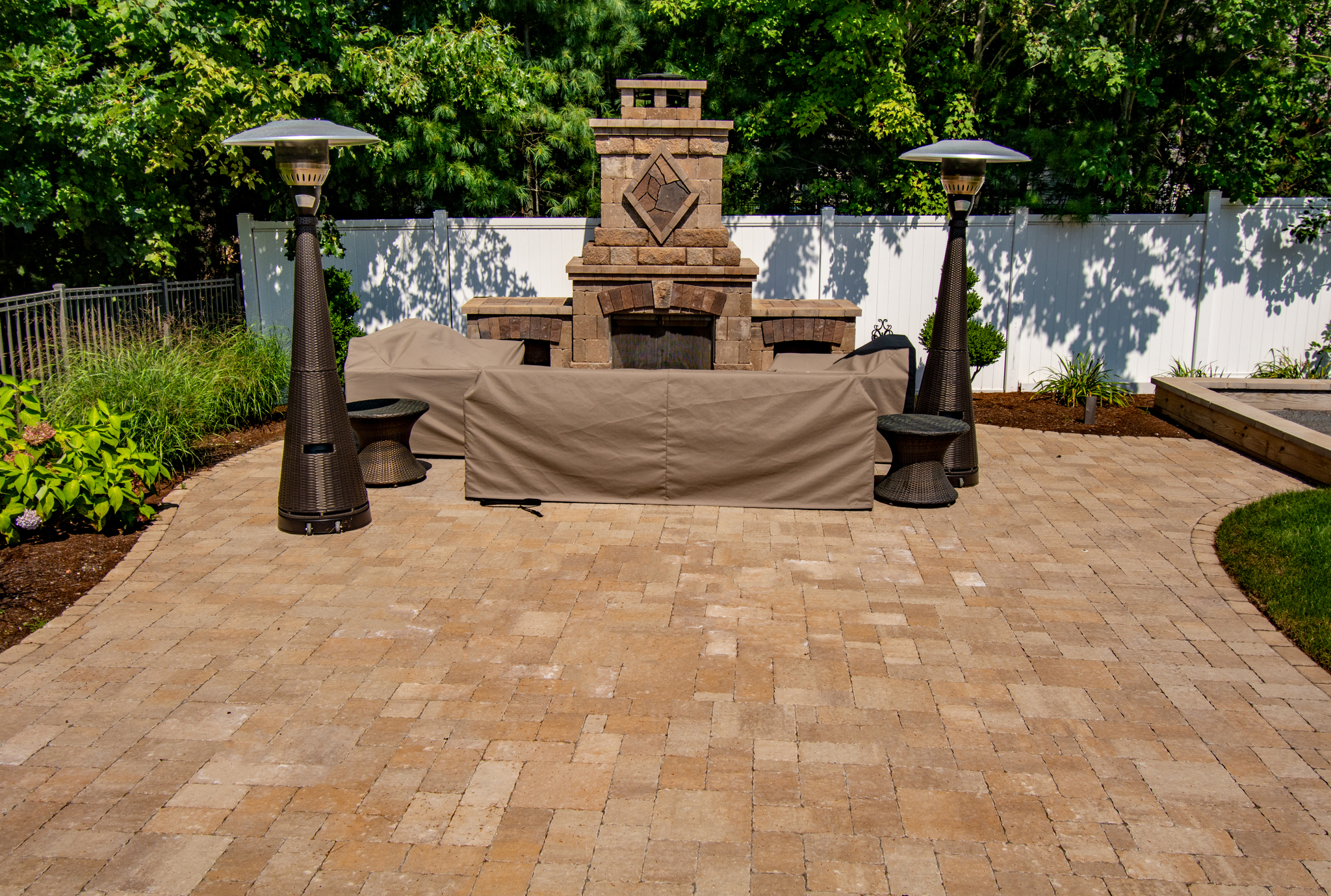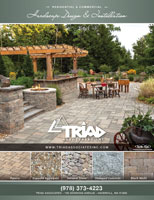Pavers are a beautiful option for your hardscape surfaces. Whether you are putting in a new driveway or you are creating a large patio for entertaining, using pavers will elevate the project and make it more stylish. Pavers have many other benefits, as well, including being easy to maintain, having more flexibility for design options, and being better for the environment because they allow for improved stormwater drainage.
There are many paver patterns that come in a wide variety of colors, shapes, textures, and sizes, giving property owners a lot of options for designs. You can achieve just about any look you like with pavers, ranging from natural and rustic aesthetics to more contemporary and streamlined designs. By working with a hardscape designer at Triad Associates, you can explore all your options and discover the perfect design to complement your property and suit your aesthetic.
How to Create a Unique Paver Pattern
To start any design process, you should first think about what you want to achieve with your project. What is the overall look and feel that you want to create? What are some designs that you have seen elsewhere and liked? Once you have that general design sense in mind, you can start to explore your options and experiment with different materials and combinations.
When designing a paver project, you should start by exploring some popular patterns and then adapt them to suit your needs. Here are some of the top paver patterns you might consider:
1. Running Bond
Running Bond is a classic paver pattern that you’ll see replicated in both exterior and interior projects. Think of a classic brick wall or even subway tile. Now you know what Running Bond looks like. It features rows of brick-shaped pavers that are staggered off-center on each row. It is a simple and neat design that can fit in with just about any decor scheme.
2. Basketweave
A Basketweave pattern is designed to look like the alternating threads of a basket. The pavers are stacked two-by-two or three-by-three into a square unit. One unit will angle down to the right, while the unit next to it will angle up and to the right. These units are placed side-by-side in diagonal rows, replicating the pattern of a basket. This is another classic design that you can use in everything from pathways to patios.
3. Herringbone
In a Herringbone design, brick pavers are placed in an L or stair-shaped pattern. One paver is placed vertically, while the next is placed horizontally by its top. The pattern only works with rectangular pavers of the same size and shape. Though it is a simple pattern, it makes a big impact. This is a popular pattern that can be repeated elsewhere in your home decor, as well, helping you to create a cohesive design scheme.
4. Cobblestone
Cobblestone paver patterns are not consistent. Instead of a pattern, they are defined more by an aesthetic. Cobblestone paver patterns use rough-hewn square or rectangular patterns, often with rounded edges, that are placed in an irregular pattern, similar to an old cobblestone road or path. This design is a great option for those who prefer a natural look.
5. Circular
Paver patterns don’t have to be linear. You can create a gorgeous circular pattern that can be used in patios, pool decks, and more. You can also embed a circular pattern within a larger pattern, such as an inset in a driveway or numerous insets within a path. You can also achieve fun results by using contrasting colors for the stone in your circular pattern and in the surrounding area. Work with your designer to explore some creative options.
6. Block Lattice
Not all pavers have to be solid. There are gorgeous pavers that have hollow centers that can be used for interesting designs. One option is to set these pavers in diagonal rows, creating a lattice pattern. You can fill the centers with gravel or let grass or other greenery grow. You can even plant wildflowers or other colorful plants in that space. This pattern allows you to create a unique and natural look for your project.
7. Pinwheel
Pinwheel paver patterns combine rectangular blocks with smaller, square blocks. The rectangular pavers are placed in a border around the smaller square, similar to the design a pinwheel has. You can get more emphasis from this pattern if you choose different colors for your rectangular and square blocks, highlighting the shape. Even alternating shades will work, such as a light gray and a dark gray.
8. Plainweave
Plainweave is similar to Basketweave, but it uses only one paver per “thread” instead of two to three. One row of pavers faces vertically, while an alternating row faces horizontally. No row is laid uninterrupted. Both rows alternate, similar to threads weaving in and out of each other. It is a simple pattern that can make a big impact when used well.
9. Soldiered
A Soldiered paver pattern is simply one that has been placed inside a border. You can choose any pattern you like for the main surface area of the project. However, that pattern is then encased in a border of pavers, usually stacked closely together in a row that faces the opposite direction. This pattern gives the design a nice, finished look, while also providing some stability for the edges of the surface.
10. Stack Bond
A Stack Bond pattern is similar to a Running Bond pattern, except that the pavers are laid directly on top of each other in each row, rather than staggered. The result looks like a perfect grid. This is a great option for those who like a bold or modern design.
11. Zigzag
You can achieve a Zigzag pattern in a number of ways. You can lay pavers in a pattern similar to the Herringbone pattern. You can also lay pavers in this pattern, but then alternate different colors so that the different rows also create a Zigzag. There are a lot of options for creative design with this pattern. You also are not limited to rectangular pavers. You can create the same alternating design with different shapes.
12. Flemish
A Flemish paver pattern uses the same pattern as a Running Bond. However, instead of using the same sized rectangular pavers throughout the pattern, it alternates between a rectangular and a square paver on each row, creating some variation in the pattern. This pattern gives you a nice option to get a twist on a traditional design.
13. Mosaic
A Mosaic can take on any pattern you like. The idea is that you place different sizes, shapes, and colors of patterns together in a way that creates a kind of picture. You might choose something simple, like a series of concentric rings, or you might choose something more elaborate, like a tableaux. You can use a wide variety of paver types for this kind of pattern, including very small and colorful stones to create unique patterns.
14. Irregular
An Irregular paver pattern is not as freeform as it may sound. There actually is some regularity in this pattern, despite its name. The pattern takes advantage of different sizes and shapes of pavers, such as a mix of squares and rectangles, and puts them together in a complex pattern. There may be eight or nine pavers involved in one “unit” that is then repeated throughout the surface. This is becoming an increasingly popular paver design because it does not have a rigid design, but it still creates an ordered look.
15. Octagonal
Octagonal pavers look like mini stop signs – without the bright red color. With an octagonal paver pattern, a small square paver is placed on the four straight sides of the octagon (when looking at it directly. This is a unique twist on a classic grid pattern, adding a new shape that provides visual interest. If you want something even more different, you can use different colors for the octagonal pavers and the square pavers.
Hire Triad Associates’ Paver Experts Today
With so many types of paver patterns available now, there are so many more patterns you can explore, including those of your own making. Many different colors of paver are now available, as are shapes, sizes, and textures. You can create any look you’d like for any hardscaping project using pavers, including driveways, pathways, patios, pool decks, and more. You aren’t limited by the patterns and materials of the past.
Call Triad Associates to schedule a consultation with one of our paver experts today and start designing your next project. Our expert designers can give you tailored feedback about what will look best on your property, and they can help you explore your options through the use of sketches, material samples, and design software. Our goal is to elevate your property to its full potential so that you can better enjoy it and can see a great return on your investment. Call us today to schedule a consultation and get started.





